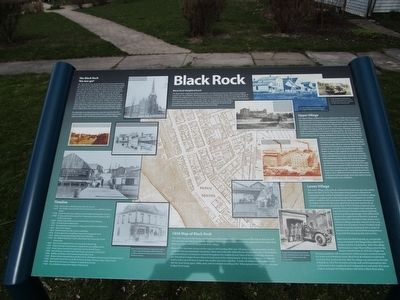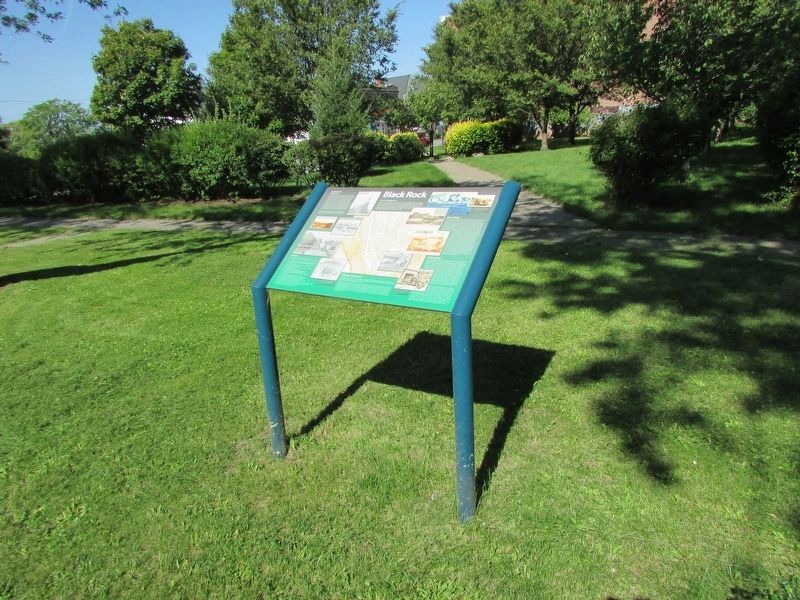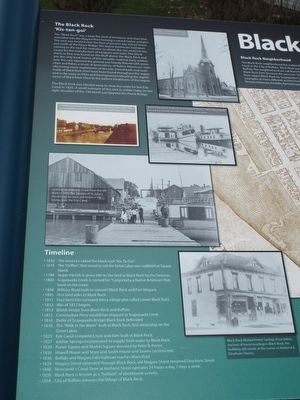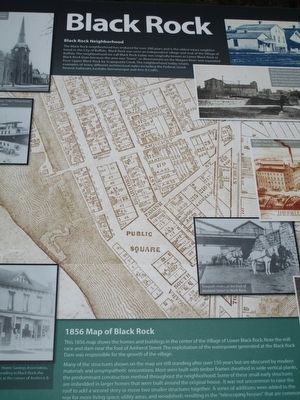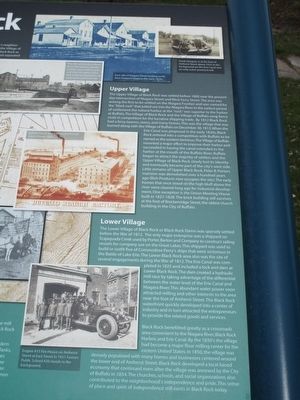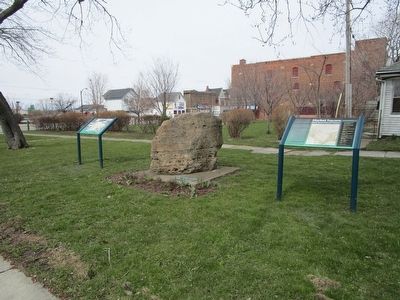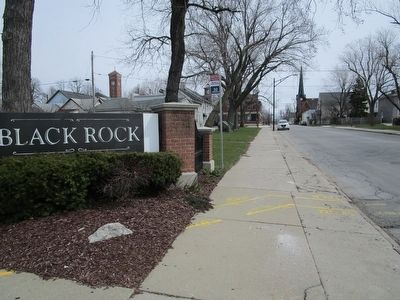Black Rock in Buffalo in Erie County, New York — The American Northeast (Mid-Atlantic)
Black Rock
Black Rock Neighborhood
The Black Rock neighborhood has endured for over 200 years and is the oldest intact neighborhood in the City of Buffalo. Black Rock was once an independent village and rival of the Village of Buffalo. The neighborhood we call Black Rock today was originally known as Lower Black Rock or Black Rock Dam because the area was "lower" or downstream on the Niagara River and separated from Upper Black Rock by Scajaquada Creek. The neighborhood today retains examples of many different architectural styles including the Federal, Greek, Revival, Italianate, Romanesque and Arts & Crafts.
The Black Rock 'Kis-tan-goi' The "Black Rock" was a large flat shelf of limestone and chert that extended into the Niagara River forming a natural harbor and pier. The rock was located near the foot of present day School Street just north of the Peace Bridge. The Native Americans had been coming to the rock for centuries to obtain the raw material necessary for the manufacture of weapons and tools. This black chert, of flint, was found on the bluff above the Black Rock and was the only local source of this valuable material. Early settlers near the rock reported the ground was heavily littered with stone chips and flakes, a result of generations of Native Americans manufacturing stone implements at the site. Arrowheads and tools made of Black Rock chert have been found throughout the region and as far away as Ohio and Pennsylvania indicating the significance of Black Rock chert to the earliest inhabitants of the region.
The Black Rock was blasted away to clear the route for the Erie Canal in 1825. A small remnant of the rock is visible today on the right shoulder of the 190 North just beyond the Peace Bridge.
Timeline
•1650 The Seneca's called the black rock "Kis-Ta-Goi"
•1679 The "Griffon, first vessel to sail the Great Lakes was outfitted at Squaw Island [renamed Unity Island].
•Jasper Parrish is given title to the land at Black Rock by the Senecas.
•1800 Scajaquada Creek is named for "Conjockety, a Native American that lived on the creek.
•1804 Military Road built to connect Black Rock and Fort Niagara.
•1805 First land sales in Black Rock.
•1811 Four farm lots surveyed into a village plot called Lower Black Rock.
•1812 War of 1812 begins.
•1813 British troops burn Black Rock and Buffalo.
•1813 Commodore Perry establishes shipyard at Scajaquada Creek.
•1814 Battle of Scajaquada Bridge; Black Rock defended.
•1818 The "Walk in the Water" built at Black Rock, first steamship on the Great Lakes.
•1825 Erie Canal completed, lock and dam built at Black Rock.
•1827 Jubilee Springs incorporated to supply fresh water to Black Rock.
•1830 Porter Square and Market Square donated by Peter B. Porter.
•1830 Howell House and store and Smith House and Tavern constructed.
•1836 Buffalo and Niagara Falls Railroad reaches Black Rock.
•1839 Niagara Street extended through Black Rock, old Niagara Street renamed Dearborn Street.
•1840 Newcomb's Canal Store at Amherst Street operates 24 hours a day, 7 days a week.
•1850 Black Rock is known as a "hotbed" of abolitionist activity.
•1854 City of Buffalo annexes the Village of Black Rock.
1856 Map of Black Rock
This 1856 map shows the homes and buildings in the center of the Village of Lower Black Rock. Note the mill race and dam near the foot of Amherst Street. The exploitation of the waterpower generated at the Black Rock Dam was responsible for the growth of the village.
Many of the structures shown on the map are still standing after over 150 years but are obscured by modern materials and unsympathetic renovations. Most were built with timber frames sheathed in wide vertical planks, the predominant construction method throughout the neighborhood. Some of these small early structures are imbedded in larger homes that were built around the original house. It was not uncommon to raise the roof to add a second story or move two smaller structures together. A series of additions were added to the rear for more living space, utility areas, and woodsheds resulting in the "telescoping houses" that are common in Black Rock today.
Upper Village
The Upper Village of Black Rock was settled before 1800 near the present day intersection of Niagara Street and West Ferry Street. The area was among the first to be settled on the Niagara Frontier and was named for the "black rock" that jutted out into the Niagara River. In the earliest period of settlement the natural harbor at the "rock" was superior to the harbor at Buffalo. The Village of Black Rock and the Village of Buffalo were fierce rivals in competition for the lucrative shipping trade. By 1812 Black Rock has a ferry, taverns, stores, and many homes. This was the village that was burned along with the Village of Buffalo on December 30, 1813. When the Erie Canal was proposed in the early 1820s, Black Rock entered into competition with Buffalo to be named as the western terminus. The Village of Buffalo mounted a major effort to improve their harbor and succeeded in having the canal extended to the harbor at the mouth of the Buffalo River. Buffalo began to attract the majority of settlers and the Upper Village of Black Rock slowly lost its identity and eventually became part of the city's west side. Little remains of Upper Black Rock. Peter B. Porter's mansion was demolished over a hundred years ago (Rich Products now occupies the site). The early homes that once stood on the high bluff above the river were cleared long ago for industrial development. One exception is the Union Meeting House built in 1827-1828. The brick building still survives at the foot of Breckenridge Street, the oldest church building in the City of Buffalo.
Lower Village
The Lower Village of Black Rock or Black Rock Dam was sparsely settled before the War of 1812. The only major enterprise was a shipyard on Scajaquada Creek used by Porter, Baron and Company to construct sailing vessels for company use on the Great Lakes. This shipyard was used to build or outfit five of Commodore Perry's ships that were victorious in the battle of Lake Erie. The Lower Black Rock area was also the site of several engagements during the War of 1812. The Erie Canal was completed in 1825 and included a lock and dam at Lower Black Rock. The dam created a hydraulic mill race by taking advantage of the differential between the water level of the Erie Canal and Niagara River. This abundant water power soon attratced milling and other interests to the area near the foot of Amherst Street. The Black Rock waterfront quickly developed into a center of industry and in turn attacted the entrepreneurs to provide the related goods and services.
Black Rock benefitted greatly as a crossroads area convenient to the Niagara River, Black Rock Harbor, and Erie Canal. By the 1830's the village has become a major flour milling center for the eastern United States. In 1850, the village was densely populated with many homes and businesses centered around the lower end of Amherst Street. Black Rock developed a local based economy that continued even after the village was annexed by the City of Buffalo in 1854. The churches, schools, and social oranizations also contributed to the neighborhood's independence and pride. This sense of place and spirit of independence still exists in Black Rock today.
[captions]
‹St. John's Evangelical Church, 85 Amherst Street, circa 1900.
‹The Erie Canal near the foot of Hamilton Street, circa 1900. The old canal bed is now the route of the New York State Thruway.
‹River Party boats at the foot of Amherst Street - 1907. These boats served the resorts on Grand Island for many years.
‹Looking up Amherst Street from the old dock in 1899. The steeple of St. John's Church can be seen just beyond the bridge over the Erie Canal.
‹Black Rock Mutual Home Savings Association, nucleus of homesteading in Black Rock, the building still stands at the corner of Amherst & Dearborn Streets.
‹East side of Niagara Street looking south from Amherst Street in the early 1870s.
‹Frank Glasgow, Jr. at the foot of Amherst Street about 1935. In the background are the Erie Canal
and an early water-powered mill.
‹The old canal locks at Black Rock. The massive wooden timbers were used to open and close the gates of the lock. In the background is an early water powered mill.
‹Buffalo Starch Factory near the foot of Austin Street, 1864.
‹Towpath mules at the foot of Amherst Street in Black Rock.
‹Engine #15 Fire House on Amherst Street at East Street in 1931. Former Public School #20 stands in the background.
Topics and series. This historical marker is listed in these topic lists: Industry & Commerce • War of 1812 • Waterways & Vessels. In addition, it is included in the Erie Canal series list. A significant historical date for this entry is December 30, 1813.
Location. 42° 56.084′ N, 78° 54.108′ W. Marker is in Buffalo, New York, in Erie County. It is in Black Rock. Marker is at the intersection of Amherst Street and Niagara Street (New York State Route 266), on the left when traveling east on Amherst Street. Touch for map. Marker is in this post office area: Buffalo NY 14207, United States of America. Touch for directions.
Other nearby markers. At least 8 other markers are within walking distance of this marker. Black Rock Harbor (here, next to this marker); Market Square (here, next to this marker); Burning of Blackrock and Buffalo (within shouting distance of this marker); a different marker also named Market Square (within shouting distance of this marker);
Stephen W. Howell (within shouting distance of this marker); Jacob Smith House and Tavern (about 400 feet away, measured in a direct line); St. John's Church (about 600 feet away); Buffalo and Niagara Falls Railroad (about 600 feet away). Touch for a list and map of all markers in Buffalo.
Credits. This page was last revised on February 16, 2023. It was originally submitted on April 11, 2016, by Anton Schwarzmueller of Wilson, New York. This page has been viewed 1,557 times since then and 153 times this year. Photos: 1. submitted on April 11, 2016, by Anton Schwarzmueller of Wilson, New York. 2. submitted on September 25, 2019, by Bill Coughlin of Woodland Park, New Jersey. 3, 4, 5, 6, 7. submitted on April 11, 2016, by Anton Schwarzmueller of Wilson, New York.
